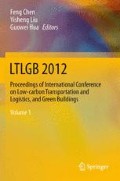Abstract
This paper proposes a stimulating mechanism for allocating subsidies to urban public transport enterprises. The allocation method is based on data envelopment analysis and the satisfaction degrees of urban public transport enterprises. It first finds the set of subsidy allocation that can keep the Pareto efficient for both the whole urban public transit industry and each urban public transport enterprise to reflect the efficiency principle, and then yields a unique subsidy allocation scheme from the set of subsidy allocations with considering the equity of satisfaction degrees. The allocation mechanism can reflect the market competition regulation on some level and benefit to achieve the goal of Green Transport in urban public transit industry. An example of allocating the subsidy among urban public transport enterprises is illustrated.
Access this chapter
Tax calculation will be finalised at checkout
Purchases are for personal use only
References
Asmild M, Paradi JC, Pastor JT (2009) Centralized resource allocation BCC models. Omega 37:40–49
Avellar JVG, Milioni AZ, Rabello TN (2007) Spherical frontier DEA model based on a constant sum of inputs. JOper Res Soc 58:1246–1251
Beasley JE (2003) Allocating fixed costs and resources via data envelopment analysis. Eur J Oper Res 147:198–216
Bertsimas D, Farias VF, Trichakis N (2011) The price of fairness. Oper Res 59(1):17–31
Charnes A, Cooper WW, Rhodes E (1978) Measuring the efficiency of decision making units. Eur J Oper Res 2:429–444
Cook WD, Kress M (1999) Characterizing an equitable allocation of shared costs: a DEA approach. Eur J Oper Res 119:652–661
Cook WD, Zhu J (2005) Allocation of shared costs among decision making units: a DEA approach. Comput Oper Res 32:2171–2178
Gomes EG, Lins MPE (2008) Modelling undesirable outputs with zero sum gains data envelopment analysis models. J Oper Res Soc 59:616–623
Karlaftis MG (2004) A DEA approach for evaluating the efficiency and effectiveness of urban transit systems. Eur J Oper Res 152:354–364
Kolm S (1971) Justice et Equite. CEPREMAP, Paris
Lao Y, Liu L (2009) Performance evaluation of bus lines with data envelopment analysis and geographic information systems. Comput Environ Urban Syst 33:247–255
Li YJ, Yang F, Liang L, Hua ZS (2009) Allocating the fixed cost as a complement of other cost inputs: a DEA approach. Eur J Oper Res 197:389–401
Li YJ, Yang M, Chen Y, Dai QZ, Liang L (2012) Allocating a fixed cost based on data envelopment analysis and satisfaction degree. Omega (in press)
Lins MPE, Gomes EG, Mello JCCBS, Mello AJRS (2003) Olympic ranking based on a zero sum gains DEA model. Eur J Oper Res 148:312–322
Lozano SA, Villa G (2004) Centralized resource allocation using data envelopment analysis. J Prod Anal 22:143–161
Lozano SA, Villa G (2005) Centralized DEA models with the possibility of downsizing source. J Oper Res Soc 56(4):357–364
Lozano SA, Villa G, Adenso-Diaz B (2004) Centralized target setting for regional recycling operations using DEA. Omega. 32:101–110
Milioni AZ, Avellar JVG, Gomes EG, Mello JCCBS (2011) An ellipsoidal frontier model: Allocating input via parametric DEA. Eur J Oper Res 209:113–121
Rawls J (1971) A theory of justice. Harvard University Press, Cambridge
Yan W, Wei Q (2011) Data envelopment analysis classification machine. Inf Sci 18:5029–5041
Zhao Y, Triantis K, Murray-Tuite P, Edara P (2011) Performance measurement of a transportation network with a downtown space reservation system: A network-DEA approach. Transp Res Part E 47:1140–1159
Acknowledgments
This research is supported by National Natural Science Foundation of China under Grants (No. 70901070 and 61101219), Science Fund for Creative Research Groups of the National Natural Science Foundation of China (No. 70821001) and the Funds for International Cooperation and Exchange of the National Natural Science Foundation of China (No. 71110107024).
Author information
Authors and Affiliations
Corresponding author
Editor information
Editors and Affiliations
Rights and permissions
Copyright information
© 2013 Springer-Verlag Berlin Heidelberg
About this paper
Cite this paper
Dai, Q., Li, Y., Xie, Q., Liang, L. (2013). Allocating the Subsidy Among Urban Public Transport Enterprises for Good Performance and Low Carbon Transportation: An Application of DEA. In: Chen, F., Liu, Y., Hua, G. (eds) LTLGB 2012. Springer, Berlin, Heidelberg. https://doi.org/10.1007/978-3-642-34651-4_15
Download citation
DOI: https://doi.org/10.1007/978-3-642-34651-4_15
Published:
Publisher Name: Springer, Berlin, Heidelberg
Print ISBN: 978-3-642-34650-7
Online ISBN: 978-3-642-34651-4
eBook Packages: Business and EconomicsBusiness and Management (R0)

